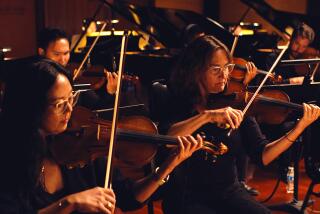Music School at SDSU Reaches Out to Nurture Fallow Community Talent
The music programs for the San Diego County schools haven’t yet found a benefactor to boost its prominence the way philanthropist Muriel Gluck has done for visual-arts instruction.
But a new effort affiliated with San Diego State University promises to at least improve the situation for instrumental music, which now averages one teacher for every 15,000 students countywide, one of the nation’s worst ratios.
The music faculty at San Diego State has established the independent Community Music School through the university’s foundation and will make its expertise available in piano, string and voice instruction beginning this week.
The school is offering more than 20 initial courses during evening and weekend hours, beginner through advanced, adult as well as children. The school will also use SDSU graduate students specializing in music education as well as selected teachers from the surrounding community at times.
Expected to Be a Recruitment Tool
“This is an opportunity for us to encourage students long before they get to college age to consider music,” said Marsha Wolfersberger, professor of music and director of the new school. “I think that a lot of us see the school as a recruitment tool, but I stress that we are here to provide not only advanced training to those with special promise but to provide basic instruction and a love of music to anyone.”
SDSU President Thomas Day calls the idea “a good way for our faculty to help fill in gaps, so that we don’t lose generations of potential performers.”
“I think since Proposition 13 (which cut public education funding especially in fine arts) we have been raising a generation of music illiterates, and we have an obligation not to let that happen.”
The school will charge tuition ranging from $100 to $225 for a 15-week course, depending on the nature of instruction. But Wolfersberger said that the school hopes to be able to take anyone regardless of ability to pay, especially if one or more applications now pending with private foundations for scholarships are approved.
“We are actively involved in fund raising, but it isn’t easy,” she said, reflecting the general difficulty that the funding of fine-arts education in San Diego has traditionally encountered.
The idea for the school grew out of a limited piano lab that Wolfersberger set up two years ago so her graduate students in piano could have regular practice in teaching.
“The expansion is not only to get a wider audience but allow us to offer a lot of unique and unusual instruction--including guitar, percussion and jazz improvisation,” Wolfersberger said.
Though the school has received only limited publicity so far, Wolfersberger has had more than 80 calls since the California State University system approved the concept in mid-May.
“We’ve placed more than 45 students already in piano, which seem to be creating the most interest so far,” she said.
Each student is interviewed for the most appropriate level of instruction. In addition, some of the students from the previous year’s smaller lab school are expected to continue under the enlarged format.
More to Read
Sign up for Essential California
The most important California stories and recommendations in your inbox every morning.
You may occasionally receive promotional content from the Los Angeles Times.










